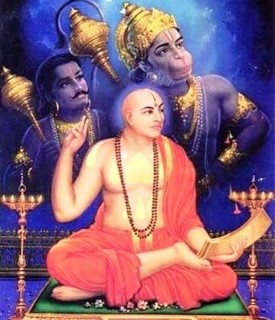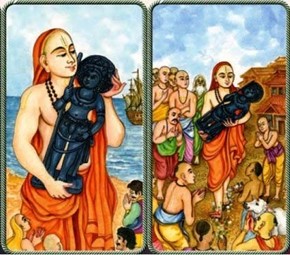Talk:The Ācāryas: Shri Madhvāchārya (1238 – 1317 CE)
By Vishal Agarwal
Madhva was a very religious child. One day, at the age of three, he disappeared from his house. After a long search, the little boy was located inside a temple several miles away. Madhva told his parents that Bhagavān Viṣṇu himself had taken him to the temple by holding his hand! Another time, a moneylender came to collect his debt from Madhva’s father, who was too poor to repay the money. Madhva went to the garden and collected a few tamarind seeds and gave them to the moneylender. Miraculously, the seeds turned into gold, and the debt was repaid in full.
Madhvācārya was not just a very intelligent student, he was also a very good sportsman. His teachers were concerned that Madhva spent all his time in swimming and wrestling, sports in which he defeated all his friends. But whenever they would question him, not only did he answer correctly all the questions related to the last lesson in class, but he would also know what the teachers were planning to teach next!
At a very young age, Madhvācārya became a sannyāsī – a wandering Hindu ascetic. Once, during his travels in North India, he was stopped threateningly by soldiers of the Muslim Sultan. Madhvācārya started talking to them in fluent Turkish, the mother tongue of the Sultan, who was so impressed that he let the Ācārya be freed.
One day, Madhvācārya was meditating on the seashore when he saw a ship being tossed violently in the waves. Madhvācārya waved his upper garment, and the winds calmed down miraculously. When the ship reached the shore, the owner gave the saint a mound of gopīcandana (a special type of yellow clay) as a gift to thank him. Madhvācārya took the mound of clay and washed it in a pond, and a beautiful mūrti of Kṛṣṇa emerged from it. Unfortunately, the mūrti turned out to be very heavy and even thirty people were not able to carry it. But, Madhvācārya stepped forward and carried it alone to a site in Uḍupi. A Kṛṣṇa maṇḍira was constructed to worship the mūrti, and Madhvācārya told everyone that the mūrti was divine as it had been sculpted by none other than Viśvakarmā. Gradually, his eight prominent disciples founded eight maṭhas (monasteries) in Uḍupi, and took turns to lead the worship in the Kṛṣṇa maṇḍira according to the rules written by Madhvācārya himself.
Madhvācārya wrote 37 books to explain his teachings. A copy of these books written by one of his own students still exists, even after almost 700 years! Madhvācārya (1238–1317 C.E.) is regarded as an avatāra of Vāyu devatā, just like Bhīma and Hanumān, which explains his great physical strength. Even today, many Hindus continue to worship at the Kṛṣṇa maṇḍira of Uḍupi, and the heads of the eight maṭhas continue to spread the message of their founding Ācārya.


